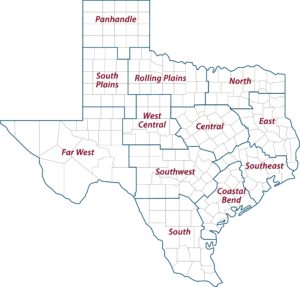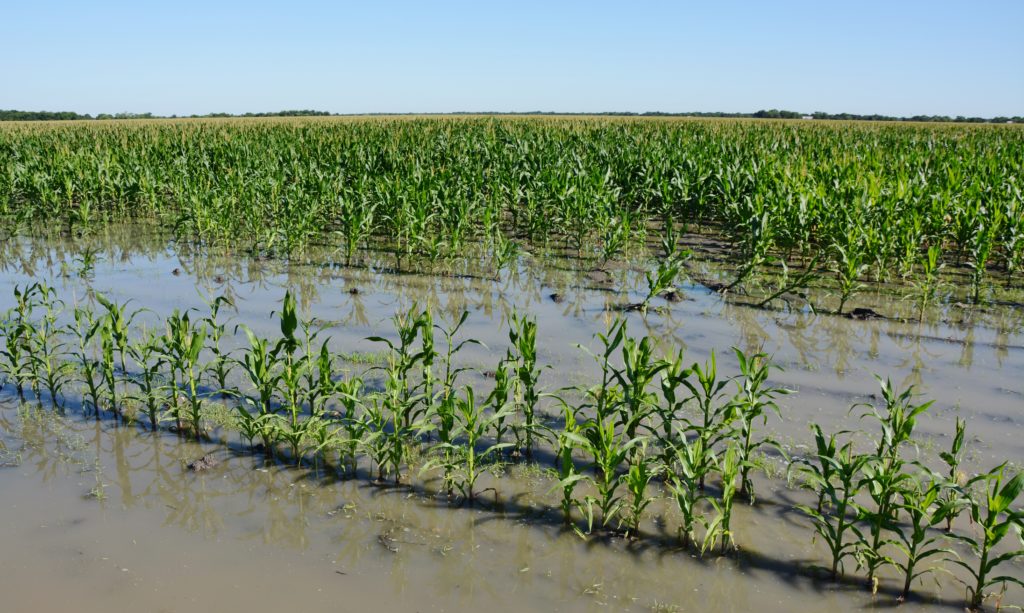Texas Corn, Sorghum Production Varied Based on Regional Moisture Levels
Texas sorghum and corn producers experienced mixed levels of success in 2019 mostly due to moisture levels on a field-by-field basis, according to a Texas A&M AgriLife Extension Service expert.
Moisture is always a major factor for any crop in Texas, but sorghum and corn yields around the state showcased how timing and too much or too little rain can impact plant performance, said Ronnie Schnell, Ph.D., AgriLife Extension agronomist, College Station.
Sorghum
Schnell said sorghum yields in some parts of the Coastal Bend and Upper Gulf Coast were very good. The crop success was attributed to favorable growing conditions and excellent management by producers.
“Sorghum acres were down, but yields were good for the most part,” he said. “A lot of it came down to when and how much rain was received.”
Sorghum yields are typically around 5,600 pounds per acre in those regions, but many producers reported 6,500-8,000 pounds per acre.
Schnell said sorghum success in the Panhandle was mixed depending on where spotty rains fell.
“The Panhandle was variable, especially on dryland fields,” he said.
Schnell said irrigated sorghum fields in the Panhandle can produce 10,000-plus pounds per acre in a good year.
In previous years, sugarcane aphids were a concern. While they still encounter sugarcane aphids, producers are better equipped to manage the pest. Sugarcane aphid-tolerant sorghum varieties, good scouting and effective spray treatments kept the pest in check for the most part, Schnell said.
Corn
Some corn producers in South and Southeast Texas dealt with too much rain but still ended the season with above-average yields while producers in the Panhandle dealt with too little moisture and ultimately mostly below-average yields. (Texas A&M AgriLife photo by Adam Russell)
Yields were also very good for corn growers in South to Central Texas, despite a very late start. Soil moisture levels and rainfall patterns delayed field activities and there were concerns about late plantings exposing plants to heat or drought conditions. However, these concerns did not come to fruition.
“Sometimes a late start pushes us to a point where heat can be very detrimental to the crop’s progress,” he said. “But it stayed cool enough, and the soil moisture was good enough that the delay didn’t really hurt yields.”
Schnell said some producers were unable to perform tillage due to wet conditions and planted in established beds. There were also some issues of lost acres due to too much rain or poorly timed rains in other areas.
“Despite a few issues in South to Central Texas, I would say yields were above average,” he said.
Typical yields in those regions are 100-150 bushels per acre, but Schnell said a good number of producers reported 150-180 bushel per acre yields.
Yields were variable in the Panhandle and were impacted by heat and drought, he said, though some acres benefited from spotty rains.
“A lot of the Panhandle is irrigated, but even those acres depend on some rain when temperatures are that high and moisture levels are so low,” he said. “If you don’t have rainfall it’s hard to keep up.”
Irrigated fields in the Panhandle average 250-300 bushels per acre, but heat and drought knocked yield results below 250 bushels per acre for some producers. In good years, yields can exceed 300 bushels per acre.
“We had corn trials in the region, and yields averaged 258 bushels per acre at one location and 298 per acre at another location,” he said. “They received close to the same amount of irrigation and rainfall. However, the higher-yielding field received a larger portion of the rainfall later in the year.”
AgriLife Extension district reporters compiled the following summaries:

The 12 Texas A&M AgriLife Extension Districts
CENTRAL: Temperatures were extremely warm, and some rain was received. One area reported 0.4 of an inch of rain. Warm-season grasses greened up in areas that received rain, but growth was slowing. Many fields of small grains had not come up, and those that had emerged needed additional moisture to keep from dying. Pecan harvest was in full swing. Livestock were in good to fair condition and were receiving supplemental feed. Stock tanks were becoming a concern as many people will run out of water for livestock due to no large rainfall events. A few cotton fields were yet to be harvested. Burn bans were lifted due to recent rains.
ROLLING PLAINS: Weather conditions were fair throughout the district. Some areas received a small amount of rain, and temperatures were cool. There was a frost in many areas across the district. Cotton producers continued to apply defoliants to prepare fields for harvest. Cotton harvest began in some areas. Wheat planting slowed, and some producers finished planting. Livestock remained in good shape.
COASTAL BEND: Conditions were mostly dry, though scattered showers were reported. Post-harvest fieldwork was underway with disking, bedding and stalk and stubble destruction. Control of regrowth cotton with herbicide was a challenge for many growers. Rangeland and pasture conditions improved in some areas, and winter pasture planting picked up. There were some reports of armyworms. Some hay producers were trying to get their last cuttings put up. Cattle remained in good condition.
EAST: Up to 4 inches of rain fell across the district. Pastures greened up, but cooler temperatures slowed production. Sabine County reported a few producers got a fourth cutting of hay rolled while others were still hopeful to make a last cutting. Pasture and rangeland conditions were fair to good. Subsoil and topsoil were adequate. Winter pastures and fall vegetables were being planted. Winter weed control was underway. Cattle markets were up from the previous week. Livestock were in fair to good condition. Producers in some areas began feeding hay. Anderson County producers were supplementing livestock with protein and energy. Wild pigs remained a problem. Armyworm infestation reports were spotty.
SOUTH PLAINS: Conditions continued to be dry and windy with unseasonably warm temperatures in some areas. No rainfall was reported. Temperatures were cold in areas, and an early freeze damaged some cotton. Many farmers were defoliating for the second time because of regrowth after rains. Farmers who defoliated early were starting to strip cotton. Cotton harvest was ramping up in some areas. Some dryland cotton was destroyed. Winter wheat was in good condition. The pumpkin harvest was complete. Some producers were finishing up corn harvest, and many were busy getting sorghum out of the fields once they had dried. Cattle were in good condition. Producers were harvesting peanuts. Pasture and rangeland were still in fair condition. Cattle were in good condition. A lack of rain was slowing pasture progress. Wheat looked good.
PANHANDLE: A freeze was reported across the district, and temperatures dropped overall. Cotton was opening in southern areas of the district and was in poor condition due to freeze in northern areas. Corn was mature. Sorghum was in good condition. Winter wheat was in excellent condition, and most fields had emerged. Subsoil and topsoil were adequate. Pastures and rangelands were in fair to good condition.
NORTH: Soil moisture was adequate to short across the district. Most counties reported temperatures dropping into the 40s during the night. Only a small amount of rain fell in a few counties. Pond levels were a major concern for some counties due to the lack of measurable precipitation. Winter wheat planting began, but a good rain was needed to promote growth. Cotton and soybeans were being harvested. Warm-season perennial pastures were going dormant, and winter pastures were being planted. A few armyworms were spotted but infestations were not as bad as in the previous years. Spring-born calves looked good and were being weaned. Summer stocker calves looked good as well. Wild pigs were moving as temperatures cooled.
FAR WEST: High temperatures averaged in the low-90s with lows in the upper-30s. Spotty precipitation brought trace amounts of rain. Cotton was being defoliated in some areas, and harvest was in full swing in others. Below-average yields were being reported so far. Producers were moving through fields at a very fast pace, and harvest was expected to be over much sooner than in most years. Winter wheat and oats were starting to sprout and cover the ground with some stands reaching 2 inches in height. Pecan producers were nearing the end of irrigation. Burkett pecans were starting to show some shuck split. Ranchers were rotating herds to fall pastures and vaccinating. Cattle were in fair to good condition. Pastures looked full of green grass and hanging on to the last warm weather before dormancy. Producers were adjusting supplemental feed plans due to the lack of rain.
WEST CENTRAL: Some parts of the district received up to 1 inch of rain while others were dry. Cotton harvest started. Small grain plantings were in full swing. Stock tank levels were extremely low. Winter feeding was underway due to poor forage quality. The cattle market opened steady. Feeder steers sold $2-$3 higher per hundredweight.
SOUTHEAST: Soil temperatures remained fairly warm through mid-October, which allowed some producers to cut hay again on a few pastures. Livestock were in fair condition. Parts of Lee and Walker counties received some rain but was still extremely dry. Rangeland and pasture ratings varied from excellent to very poor with good being most common. Soil moisture levels ranged from adequate to very short with adequate being most common.
SOUTHWEST: A cool front dropped temperatures significantly and brought some much-needed rain. Rains of up to 1.5 inches improved soil moisture conditions. Pastures should improve with more chances of rain forecast. Producers were preparing to plant small grains and winter pastures. Deer populations in anthrax-affected areas around Sutton County were reduced 65%-90%. Livestock were in fair condition. Supplemental feeding of livestock continued.
SOUTH: Weather was mild with short to adequate soil moisture levels. Temperatures cooled due to a cool front in some areas. Some areas received rain. Maverick County reported up to half an inch of rain, and LaSalle County reported up to 1 inch. Topsoil was moist in areas that received good rains. Other areas remained critically dry. Cotulla reported only 9 inches of rainfall so far for the year. Pasture and rangeland conditions were poor but were improving in areas that received rain. Hay producers were making final cuttings with minimal yields reported. Livestock were in fair to good condition as supplemental feeding continued. Some producers were culling herds deeper than usual. Cattle markets were seasonally weak and not expected to rebound until early next year. Producers were working to get small grains and winter forages planted. Armyworms were reported. Peanut harvest should pick up soon. Producers reported peanut fields were impacted by wild pigs and other wildlife. Most warm-season vegetable crops were harvested, and Coastal Bermuda pastures were in the final stage of production. Cabbage and spinach made good progress due to cooler temperatures. Pecan orchards were doing well with no pest reports. Cotton gins were active.
Source: Texas AgriLife Extension

